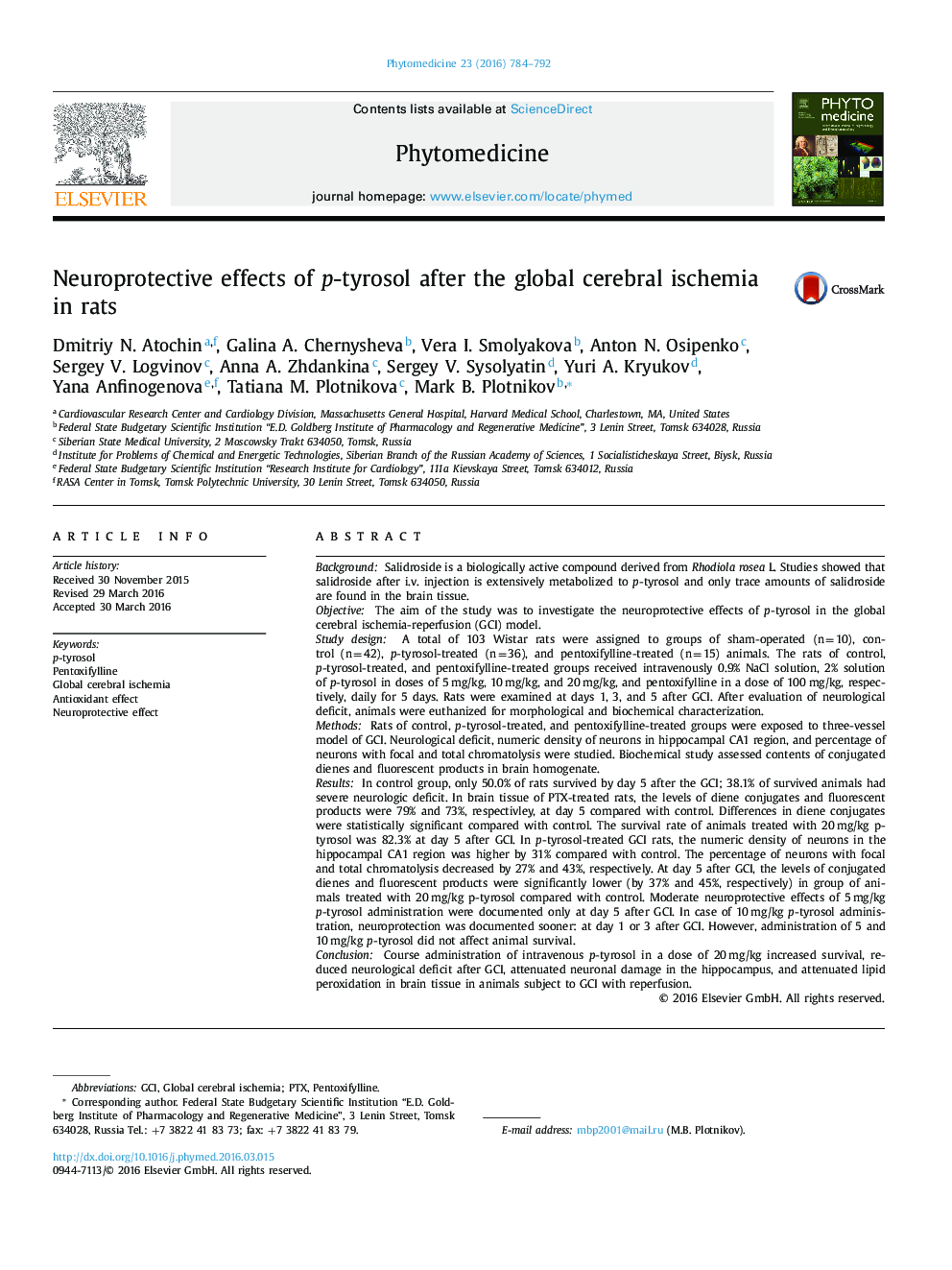| کد مقاله | کد نشریه | سال انتشار | مقاله انگلیسی | نسخه تمام متن |
|---|---|---|---|---|
| 2496315 | 1116121 | 2016 | 9 صفحه PDF | دانلود رایگان |

BackgroundSalidroside is a biologically active compound derived from Rhodiola rosea L. Studies showed that salidroside after i.v. injection is extensively metabolized to p-tyrosol and only trace amounts of salidroside are found in the brain tissue.ObjectiveThe aim of the study was to investigate the neuroprotective effects of p-tyrosol in the global cerebral ischemia-reperfusion (GCI) model.Study designA total of 103 Wistar rats were assigned to groups of sham-operated (n = 10), control (n = 42), p-tyrosol-treated (n = 36), and pentoxifylline-treated (n = 15) animals. The rats of control, p-tyrosol-treated, and pentoxifylline-treated groups received intravenously 0.9% NaCl solution, 2% solution of p-tyrosol in doses of 5 mg/kg, 10 mg/kg, and 20 mg/kg, and pentoxifylline in a dose of 100 mg/kg, respectively, daily for 5 days. Rats were examined at days 1, 3, and 5 after GCI. After evaluation of neurological deficit, animals were euthanized for morphological and biochemical characterization.MethodsRats of control, p-tyrosol-treated, and pentoxifylline-treated groups were exposed to three-vessel model of GCI. Neurological deficit, numeric density of neurons in hippocampal CA1 region, and percentage of neurons with focal and total chromatolysis were studied. Biochemical study assessed contents of conjugated dienes and fluorescent products in brain homogenate.ResultsIn control group, only 50.0% of rats survived by day 5 after the GCI; 38.1% of survived animals had severe neurologic deficit. In brain tissue of PTX-treated rats, the levels of diene conjugates and fluorescent products were 79% and 73%, respectivley, at day 5 compared with control. Differences in diene conjugates were statistically significant compared with control. The survival rate of animals treated with 20 mg/kg p-tyrosol was 82.3% at day 5 after GCI. In p-tyrosol-treated GCI rats, the numeric density of neurons in the hippocampal CA1 region was higher by 31% compared with control. The percentage of neurons with focal and total chromatolysis decreased by 27% and 43%, respectively. At day 5 after GCI, the levels of conjugated dienes and fluorescent products were significantly lower (by 37% and 45%, respectively) in group of animals treated with 20 mg/kg p-tyrosol compared with control. Moderate neuroprotective effects of 5 mg/kg p-tyrosol administration were documented only at day 5 after GCI. In case of 10 mg/kg p-tyrosol administration, neuroprotection was documented sooner: at day 1 or 3 after GCI. However, administration of 5 and 10 mg/kg p-tyrosol did not affect animal survival.ConclusionCourse administration of intravenous p-tyrosol in a dose of 20 mg/kg increased survival, reduced neurological deficit after GCI, attenuated neuronal damage in the hippocampus, and attenuated lipid peroxidation in brain tissue in animals subject to GCI with reperfusion.
Figure optionsDownload high-quality image (299 K)Download as PowerPoint slide
Journal: Phytomedicine - Volume 23, Issue 7, 15 June 2016, Pages 784–792